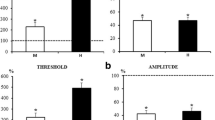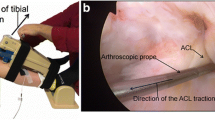Abstract
Meniscal lesions are among the most common knee injuries and substantially affect the mechanical function of the knee joint. In addition, the presence of mechanoreceptors in the meniscus suggests that the menisci are also involved in the sensorimotor control of the knee. The objective of this study was to investigate the influence of an isolated meniscal lesion on the reflex behaviour of the hamstring muscles, which are involved in the sensorimotor control of the knee joint. For this purpose, we mechanically induced tibial translation in 19 patients in a standing position and analysed the biphasic response of the hamstrings consisting of a short-latency response (SLR) and a medium-latency response (MLR). Moreover, we determined anterior tibial translation. A comparison of electromyographic data for the healthy legs versus the injured legs showed no significant differences in either SLRs or MLRs. Although there was a tendency to an increase in tibial translation, no significant difference between the legs in anterior tibial translation was found. In conclusion, our experimental work did not reveal any substantial effects of a meniscal lesion on the reflex behaviour of the hamstrings. Our data suggest that the menisci appear to play only a minor role for the sensorimotor induced anterior posterior knee stability.



Similar content being viewed by others

References
Aagaard H, Verdonk R (1999) Function of the normal meniscus and consequences of meniscal resection. Scand J Med Sci Sports 9:134–140
Allen CR, Wong EK, Livesay GA, Sakane M, Fu FH, Woo SL (2000) Importance of the medial meniscus in the anterior cruciate ligament-deficient knee. J Orthop Res 18:109–115
Assimakopoulos AP, Katonis PG, Agapitos MV, Exarchou EI (1992) The innervation of the human meniscus. Clin Orthop Relat Res 275: 232–236
Beard DJ, Kyberd PJ, O’Connor JJ, Fergusson CM, Dodd CA (1994) Reflex hamstring contraction latency in anterior cruciate ligament deficiency. J Orthop Res 12:219–228
Bonfim TR, Jansen Paccola CA, Barela JA (2003) Proprioceptive and behavior impairments in individuals with anterior cruciate ligament reconstructed knees. Arch Phys Med Rehabil 84:1217–1223
Bruhn S (1999) [Improved measurement of knee-joint stability. The Michael-Jager Prize for a Stuttgart research group]. Orthopade 28:819
Dhaher YY, Tsoumanis AD, Rymer WZ (2003) Reflex muscle contractions can be elicited by valgus positional perturbations of the human knee. J Biomech 36:199–209
Dyhre-Poulsen P, Krogsgaard MR (2000) Muscular reflexes elicited by electrical stimulation of the anterior cruciate ligament in humans. J Appl Physiol 89:2191–2195
Faist M, Blahak C, Duysens J, Berger W (1999) Modulation of the biceps femoris tendon jerk reflex during human locomotion. Exp Brain Res 125:265–270
Freeman MA, Wyke B (1967) The innervation of the knee joint: an anatomical and histological study in the cat. J Anat 101:505–532
Friemert B, Bumann-Melnyk M, Faist M, Schwarz W, Gerngross H, Claes L (2005) Differentiation of hamstring short latency versus medium latency responses after tibia translation. Exp Brain Res 160:1–9
Friemert B, Faist M, Spengler C, Gerngross H, Claes L, Melnyk M (2005) Intraoperative direct mechanical stimulation of the anterior cruciate ligament elicits short and medium latency hamstring reflexes. J Neurophysiol 94:3996–4001
Grey MJ, Ladouceur M, Andersen JB, Nielsen JB, Sinkjaer T (2001) Group II muscle afferents probably contribute to the medium latency soleus stretch reflex during walking in humans. J Physiol 534:925–933
Hogervorst T, Brand RA (1998) Mechanoreceptors in joint function. J Bone Joint Surg Am 80:1365–1378
Jerosch J, Prymka M (1996) Proprioception and joint stability. Knee Surg Sports Traumatol Arthrosc 4:171–179
Jerosch J, Prymka M, Castro WH (1996) Proprioception of knee joints with a lesion of the medial meniscus. Acta Orthop Belg 62:41–45
Johansson H, Lorentzon R, Sjolander P, Sojka P (1990) The anterior cruciate ligament. A sensor acting on the y-muscle-spindle systems of muscles around the knee joint. Neuro Orthop 9:1–8
Johansson H, Sjolander P, Sojka P (1986) Actions on gamma-motoneurones elicited by electrical stimulation of joint afferent fibres in the hind limb of the cat. J Physiol 375:137–152
Johansson H, Sjolander P, Sojka P (1990) Activity in receptor afferents from the anterior cruciate ligament evokes reflex effects on fusimotor neurones. Neurosci Res 8:54–59
Johansson H, Sjolander P, Sojka P (1991) A sensory role for the cruciate ligaments. Clin Orthop 268:161–178
Melnyk M, Faist M, Gothner M, Claes L, Friemert B (2007) Changes in stretch reflex excitability are related to “giving way” symptoms in patients with anterior cruciate ligament rupture. J Neurophysiol 97:474–480
More RC, Karras BT, Neiman R, Fritschy D, Woo SL, Daniel DM (1993) Hamstrings - an anterior cruciate ligament protagonist. An in vitro study. Am J Sports Med 21:231–237
Muller W (1994) [Menisci and knee stability]. Orthopade 23:93–97
Perry J (1992) Gait analysis, Slack, Thorofare, NJ
Saygi B, Yildirim Y, Berker N, Ofluoglu D, Karadag-Saydi E, Karahan M (2005) Evaluation of the neurosensory function of the medial meniscus in humans. Arthroscopy 21:1468–1472
Schieppati M, Nardone A (1997) Medium-latency stretch reflexes of foot and leg muscles analysed by cooling the lower limb in standing humans. J Physiol 503:691–698
Solomonow M, Baratta R, Zhou BH, Shoji H, Bose W, Beck C, D’Ambrosia R (1987) The synergistic action of the anterior cruciate ligament and thigh muscles in maintaining joint stability. Am J Sports Med 15:207–231
Solomonow M, Krogsgaard M (2001) Sensorimotor control of knee stability. A review. Scand J Med Sci Sports 11:64–80
Swash M (1986) Position sense in a damaged knee. J Neurol Neurosurg Psychiatry 49:100–101
Thijs Y, Witvrouw E, Evens B, Coorevits P, Almqvist F, Verdonk R (2007) A prospective study on knee proprioception after meniscal allograft transplantation. Scand J Med Sci Sports 17:223–229
Valeriani M, Restuccia D, DiLazzaro V, Franceschi F, Fabbriciani C, Tonali P (1996) Central nervous system modifications in patients with lesion of the anterior cruciate ligament of the knee. Brain 119:1751–1762
Yanagawa T, Shelburne K, Serpas F, Pandy M (2002) Effect of hamstrings muscle action on stability of the ACL-deficient knee in isokinetic extension exercise. Clin Biomech 17:705–712
Author information
Authors and Affiliations
Corresponding author
Rights and permissions
About this article
Cite this article
Friemert, B., Wiemer, B., Claes, L. et al. The influence of meniscal lesions on reflex activity in the hamstring muscles. Knee Surg Sports Traumatol Arthr 15, 1198–1203 (2007). https://doi.org/10.1007/s00167-007-0361-5
Received:
Accepted:
Published:
Issue Date:
DOI: https://doi.org/10.1007/s00167-007-0361-5



